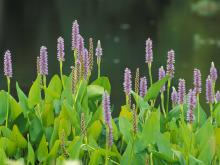Wildflowers, Grasses and Other Nonwoody Plants
Media

Species Types
Scientific Name
Prunella vulgaris
Description
A square-stemmed plant with opposite leaves, self-heal bears two-lipped blue, lavender, or violet flowers in a cylindrical head. We have two varieties of self-heal in Missouri, one native and one introduced.
Media

Species Types
Scientific Name
Chenopodium album
Description
Lamb’s quarters won’t win any beauty contests for its flowers, but it merits an award for being both a common garden weed as well as a nutritious leafy green valued around the world.
Media

Species Types
Scientific Name
Pontederia cordata
Description
The handsome violet-blue flower spikes of pickerel weed stand out vividly at the edges of ponds. One of our few blue-flowering pond plants, pickerel weed is easy to identify by its color alone.
Media

Species Types
Scientific Name
Barbarea vulgaris
Description
Yellow rocket is a mustard native to Eurasia that was introduced long ago and today is found across North America. The mustard family used to be called the Cruciferae, because of the cross shape formed by the four petals.
See Also
About Wildflowers, Grasses and Other Nonwoody Plants in Missouri
A very simple way of thinking about the green world is to divide the vascular plants into two groups: woody and nonwoody (or herbaceous). But this is an artificial division; many plant families include some species that are woody and some that are not. The diversity of nonwoody vascular plants is staggering! Think of all the ferns, grasses, sedges, lilies, peas, sunflowers, nightshades, milkweeds, mustards, mints, and mallows — weeds and wildflowers — and many more!





















